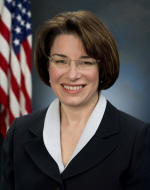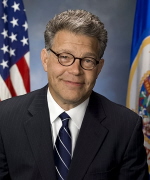Are Klobuchar and Franken Exceeding Expectations? MN Senators Receive All-Time High Job Approval Marks

Neither political party has been immune to the public backlash, although Democrats (who control the legislative and executive branches of the federal government and the majority of governorships and state legislatures nationwide) have seemingly endured the brunt of the effects of changing public attitudes. Several pundits predict voter dissatisfaction could create a shakeup of Congress in the 2010 elections, with Democratic incumbents particularly vulnerable.
Despite these trends, the Minnesota U.S. Senate delegation of Amy Klobuchar and Al Franken stands apart from those of the other 12 states tracked by the polling organization SurveyUSA. Not only are Klobuchar and Franken enjoying their highest approval ratings since being elected in 2006 and 2008 respectively, they are also the only two Senators among the 25+ tracked by SurveyUSA who currently enjoy job performance ratings higher than the percentage of voters who elected them into office.
The latest round of monthly SurveyUSA polling, conducted of 600 Minnesota adults September 27-28, finds Klobuchar with an approval rating of 64 percent and Franken with an approval rating of 49 percent.
The 64 percent mark is the highest ever notched for Senator Klobuchar across 31 SurveyUSA polls conducted since she first took office in D.C. in January 2007. Minnesota’s senior senator had previously peaked at 63 percent in December 2008.
Franken’s approval rating has increased slightly each month in SurveyUSA polling since assuming office earlier this summer – 43 percent in July, 45 percent in August, and 49 percent in September.

· Franken’s 49 percent approval rating is 7 points higher than the 42 percent of the vote he received last November in his high profile contest against Republican Norm Coleman (and Independence Party candidate Dean Barkley, whose strong 15 percent showing undoubtedly depressed the percentage of the vote received by both Franken and Coleman).
· Klobuchar’s 64 percent job approval rating is 6 points higher than the 58 percent of the vote she received on Election Day in 2006 when she won DFLer Mark Dayton’s open seat.
Nearly half of the Senators tracked by SurveyUSA have experienced a double-digit decrease when comparing their current approval rating vis-à-vis the percentage of vote they received the last time they were on the ballot. Among these are fellow Upper Midwesterners Chuck Grassley (-20 points) and Tom Harkin (-19 points) from Iowa, and Herb Kohl from Wisconsin (-14).
In one sense, it is not surprising to see such Senators have approval ratings that are lower than the percentage of the vote they received on Election Day. The SurveyUSA polls are conducted of adults, not voters or likely voters, and, as such, the respondents include a number of disinterested, disengaged, or otherwise disgusted residents who did not vote at all the last time the Senator was on the ballot, and are thus perhaps disinclined to support their state’s officeholders generally.
This is what makes the numbers of Franken and Klobuchar so remarkable. They have done what many of their colleagues in the Senate have not: improve their standing among their respective statewide population vis-à-vis voter support since their last election. And Franken and Klobuchar have done so in light of continued serious economic challenges facing D.C. and the State of Minnesota, as well as the apparent declining political currency of the Democratic Party nationwide.
For example, in the Upper Midwest region, Democratic Governors Jim Doyle (WI) and Chet Culver (IA) have endured the lowest approval ratings of their respective tenures in recent months, as has Iowa Democrat Tom Harkin – whose 44 percent approval mark in September is down 19 points during the past 10 months (63 percent in December 2008).
The Franken/Klobuchar numbers also hold when looking at the percent change between current approval ratings and percentage of vote received.
U.S. Senatorial Approval Ratings Vis-à-vis Percentage of Vote Received
|
State
|
Senator
|
Elected
|
Vote
|
Approval
|
Diff.
|
% Diff.
|
|
MN
|
Franken
|
2008
|
42
|
49
|
+7
|
+16.7
|
|
MN
|
Klobuchar
|
2006
|
58
|
64
|
+6
|
+10.3
|
|
MO
|
McCaskill
|
2006
|
50
|
50
|
0
|
0.0
|
|
AL
|
Sessions
|
2008
|
63
|
62
|
-1
|
-1.6
|
|
VA
|
Webb
|
2006
|
50
|
48
|
-2
|
-4.0
|
|
VA
|
Warner
|
2008
|
65
|
61
|
-4
|
-6.2
|
|
KY
|
McConnell
|
2008
|
53
|
49
|
-4
|
-7.5
|
|
NY
|
Schumer
|
2004
|
71
|
65
|
-6
|
-8.5
|
|
KS
|
Roberts
|
2008
|
60
|
54
|
-6
|
-10.0
|
|
WI
|
Feingold
|
2004
|
55
|
49
|
-6
|
-10.9
|
|
NM
|
Udall
|
2008
|
61
|
54
|
-7
|
-11.5
|
|
OR
|
Wyden
|
2004
|
63
|
55
|
-8
|
-12.7
|
|
WA
|
Murray
|
2004
|
55
|
48
|
-7
|
-12.7
|
|
OR
|
Merkley
|
2008
|
49
|
42
|
-7
|
-14.3
|
|
AL
|
Shelby
|
2004
|
68
|
58
|
-10
|
-14.7
|
|
NM
|
Bingaman
|
2006
|
71
|
58
|
-13
|
-18.3
|
|
WA
|
Cantwell
|
2006
|
57
|
46
|
-11
|
-19.3
|
|
MO
|
Bond
|
2004
|
56
|
45
|
-11
|
-19.6
|
|
WI
|
Kohl
|
2006
|
67
|
53
|
-14
|
-20.9
|
|
CA
|
Fienstein
|
2006
|
59
|
46
|
-13
|
-22.0
|
|
CA
|
Boxer
|
2004
|
57
|
41
|
-16
|
-28.1
|
|
IA
|
Grassley
|
2004
|
70
|
50
|
-20
|
-28.6
|
|
IA
|
Harkin
|
2008
|
63
|
44
|
-19
|
-30.2
|
|
KS
|
Brownback
|
2004
|
69
|
48
|
-21
|
-30.4
|
|
KY
|
Bunning
|
2004
|
51
|
35
|
-16
|
-31.4
|
Note: SurveyUSA and election data compiled by Smart Politics.
Follow Smart Politics on Twitter.
